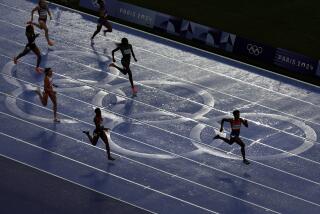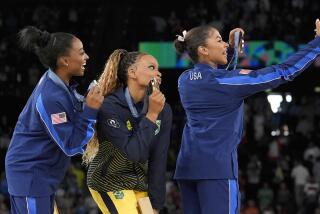Sports Injuries Up Among Women
- Share via
WASHINGTON — From wrestling to ice hockey to baseball, there are very few sports left in which women have not stepped up to participate, either competitively or recreationally.
Major health benefits are accrued in women who participate in regular physical activity. But with the growth of women in sports--estimated at 2 million interscholastic athletes and countless older weekend warriors--comes the first hint of a downside: Women are getting hurt more and appear more vulnerable to certain kinds of sports injuries.
Moreover, there is scant knowledge not only on how to help women prevent sports injuries, but how and why they occur.
And it may dismay women athletes to know that even sporting goods manufacturers, who have doled out considerable advertising money to attract female buyers, have not engaged in designing products and equipment specifically for women’s bodies.
“As an orthopedic surgeon, I’ve been terrified by the growing number of sports injuries women are facing,” said Dr. Laura Tosi, a surgeon at George Washington University Medical School and chair of a seminar at the annual Women’s Health Congress here last week, in which sports injuries were showcased as an emerging concern in women’s health.
While the burst of female sports injuries may be discouraging, it should not deter women from pursuing athletic goals, said Dr. Lisa R. Callahan, director of the Women’s Sports Medicine Center in New York City.
“Yes, women’s injuries are increasing. But we’re also going to see more young women grow up healthier because they’re participating in sports,” she said.
Women athletes--whether they’re competitors or recreational athletes--have not been the focus of studies in sports medicine until recently, Callahan said. It was only in 1972 that Title IX banned discrimination in federally assisted education programs, giving school-age athletes an equal opportunity to compete.
“Even the women’s marathon wasn’t added to the Olympics until 1984,” Callahan said. “So what we know [about women’s injuries] is only from what we’ve seen in the past 10 to 15 years.”
*
One of the major questions for researchers like Callahan is how much women’s physiology, training and equipment each contribute to injuries.
“Is it the sport or is it the athlete? Is it because the athlete is a woman?” Callahan asked.
Of greatest concern to coaches is the dramatically high number of women suffering anterior cruciate ligament injuries. The ACL is a major stabilizing ligament in the knee.
“Study after study has shown that women have more ACL injuries, particularly in handball, soccer, basketball and, to a lesser degree, skiing and gymnastics,” Callahan said. “But the thing that is fascinating with ACL injuries in women is, they tend to be non-contact. Males tend to have contact ACL injuries--a violent, aggressive blow, such as those seen in football.”
Why does this devastating injury occur more often in women? (According to research, women suffer as many as eight times the number of ACL injuries as men.) Like almost all female sports injuries, researchers aren’t sure. According to Callahan, there are both intrinsic and extrinsic factors that probably contribute. For example, women have a wider pelvis, which creates more angle between the pelvis, knee and floor. And--although there is not much evidence that it matters--women’s ligaments are smaller.
Women also have more laxity in their joints, a condition related to circulating female sex hormones. Indeed, the ACL has estrogen receptor cells that might encourage such laxity in that joint. Laxity means the tissue is more likely to tear.
Hormones related to the menstrual cycle may contribute to injury vulnerability. Callahan is beginning a study to see if ACL injuries can be correlated to a particular time of the menstrual cycle. Moreover, the absence of menstruation--common among some elite athletes--can accelerate bone loss and increase the risk of stress fractures.
Stress fractures, of course, can be linked to over-training, and that is often the cause of fractures in the tibia. But, Callahan said, stress fractures in the femoral neck bone and pelvis are more likely to be precipitated by inadequate bone health in women.
“Having your menstrual cycle is more important than people think,” she warned younger athletes.
But Callahan cautions against pinning women’s sports injuries on the idea that their bodies aren’t made for such endeavors. In fact, studies show that women athletes can achieve about 80% of men’s muscle strength when taking into account body size.
“Women’s bodies may not be able to withstand football. But we are better, physiologically, at other sports, such as endurance sports. We’re physiologically different. And you have to understand that if you want to participate or coach,” she said.
*
She advises everyone, male and female, to consider their body type and size before devoting themselves to a particular sport.
It’s also quite possible, Callahan said, that women are not benefiting from the same coaching, training and gear that male athletes have acquired. Women may lack some of the skills or training that keep their male counterparts healthy. For example, one recent study showed that women basketball players don’t generate nearly as much squeaking noise on the court as men do. This may mean nothing, Callahan said. But, she added: “It could be because how a woman moves is different.”
Athletic gear designed for women’s bodies and playing styles could help reduce injuries, said Dr. Carol Frey, a women’s shoe and foot expert at USC.
“Manufactures still do not make a specific women’s shoe for track and field,” Frey said. “They take a man’s shoe and scale it down. But a woman’s foot is not shaped like a man’s foot. Since 1994, females have been buying more athletic shoes then men. Yet, [manufacturers] still do not generally make shoes for the female foot.”
However, according to a report on women’s gear being prepared by the Sporting Goods Manufacturers Assn., more companies are consulting women when coming up with new designs.
“It is very difficult for a woman to walk into a store selling athletic footwear, apparel and equipment and recognize herself,” says Sue Levin, women’s brand director at Nike. “It’s something we are going to be working very hard to change over the next several years.”






